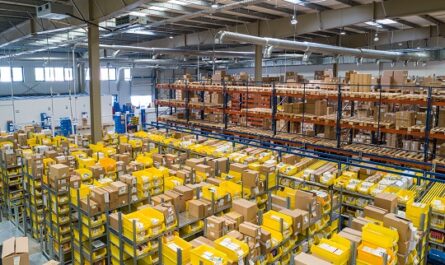Supply chain management (SCM) is an important concept in modern business. In today’s complex and rapidly changing business world, SCM is becoming increasingly important in helping companies improve their efficiency and effectiveness of their operations.
The role of SCM in the supply chain itself includes managing the flow of goods, services, and information from suppliers to end customers with the goal of improving customer satisfaction and company profits.
In this post, we will discuss SCM and its role in a company’s supply chain.
We will also discuss which departments are involved in the supply chain and how they can work together to improve efficiency and effectiveness of the company’s operations.
Additionally, we will discuss whether the SCM department should stand alone or be merged with other departments, and what factors need to be considered in choosing that option.
But before we dive deeper, make sure you have joined the scmguide telegram channel so you don’t miss notifications of the latest posts from this blog and gain more insights on supply chain management.
Table of Contents
What is SCM?
SCM stands for Supply Chain Management.
If we define it, SCM is an approach used to manage the activities involved in the procurement, production, and distribution of products or services from a company to end customers.
What is the purpose of SCM?
The main goal of SCM is to increase the efficiency and effectiveness of the entire supply chain by minimizing costs, improving product quality, and better meeting customer needs and wants.

SCM involves complex coordination between various parties in the supply chain, such as manufacturers, suppliers, distributors, and retailers.
SCM also involves the use of information technology and management systems to help manage information and facilitate coordination between parties involved in the supply chain.
With effective SCM, companies can increase profits, reduce costs, and improve customer satisfaction.
What is the function of SCM?
After understanding what SCM is, the next question is, what is the purpose of SCM?
Supply Chain Management (SCM) has several important functions.
Its goal is to manage the activities within the supply chain and ensure that the company’s business objectives are met.
There are several functions of SCM. Let’s take a look.
Planning and Control
This function includes planning for raw material requirements, production, and distribution of products or services, as well as inventory control, cost control, and delivery time control.
Procurement
This function includes the procurement of raw materials and components needed for the production of products or services, as well as the selection of suppliers who can provide the best quality and price.
Production
This function includes managing production from start to finish, including selecting appropriate production technology, production planning and scheduling, and product quality control.
Delivery and Distribution
This function includes managing the delivery of products from the factory or warehouse to end consumers efficiently and effectively.
Development and Innovation
This function includes developing new products, improving products, or innovating in production or delivery processes.
Risk Management
This function includes identifying and mitigating risks throughout the supply chain to minimize negative impacts on the company’s business.
By understanding and implementing these SCM functions well, companies can improve the efficiency and effectiveness of their supply chains, improve product quality, and reduce production and distribution costs.
You might also like:
- Small Discrepancy in Stocktaking Results, Can It Be Ignored?
- Can Excess Inventory Benefit Your Business?
Departments that should carry out SCM functions
The next question is, which departments should carry out these SCM functions?
SCM functions must be implemented in an integrated manner and involve several departments within a company.
Usually, the following departments will be involved in the implementation of SCM functions.
Procurement Department
This department is responsible for identifying and selecting suppliers, negotiating prices, and managing the procurement process of raw materials and components needed for the production of products or services.
Production Department
This department is responsible for planning and managing the production of products or services from start to finish, including selecting appropriate production technology, production planning and scheduling, and product quality control.
Logistics Department
This department is responsible for managing the shipment and distribution of products from factories or warehouses to end customers, including planning shipping routes, arranging shipments, and controlling the cost and timing of deliveries.
Inventory Management Department
This department is responsible for managing the inventory of raw materials, finished goods, and work-in-process (WIP) in production.
This function includes inventory planning, monitoring inventory levels, and controlling inventory costs.
Marketing Department
This department is responsible for understanding customer needs and desires and developing marketing strategies that meet the needs of the market.
This department can provide important input into production planning and product delivery.
Information Technology (IT) Department
This department is responsible for developing and managing information systems that support SCM functions, such as inventory management systems, production management systems, or delivery management systems.
It is important to remember that SCM functions involve all departments within a company and require good coordination between these departments.
Good coordination can ensure the achievement of SCM goals and improve the performance of the entire supply chain.
Should the SCM Department stand alone or be merged with other departments?
This is an interesting question. Should the SCM Department stand alone, or should it be merged with other departments?
What about in your workplace?
Or, when you want to improve SCM functions in your workplace, which option should you choose?

The decision whether the SCM Department should stand alone or be merged with other departments actually depends on the characteristics and needs of each company.
But, in general, there are two common approaches that you can apply.
Centralized Approach
This approach means that the SCM Department is managed centrally and stands alone as a separate department in the company.
Usually, this approach is applied to companies that have complex supply chains and require separate management to ensure smooth operations.
With a separate SCM department, it will be more focused on managing inventory, shipping, and suppliers, and minimizing operational risks throughout the supply chain.
Decentralized Approach
In this approach, the SCM function is managed by other departments within the company, such as procurement, production, or logistics departments.
This approach is usually applied to companies with simple supply chains that do not require separate management.
This approach can be more effective in managing SCM activities because other departments can be more integrated and have a more comprehensive vision of the company’s operations.
However, regardless of which approach is used, it is important to ensure that all departments involved in SCM work in a coordinated and integrated manner to achieve the company’s goals.
Good SCM performance requires good cooperation and communication between departments as well as the adoption of the latest technology and management methods.
You might also like:
- Why the Right Mindset is Needed in Supply Chain Management
- How to Treat KPIs the Right Way to Improve Your Supply Chain Performance
If the SCM department stands alone, separated from other departments, then what is the role of the SCM department?
Functionally, all SCM roles are already managed by several departments such as PPIC, Procurement, Logistics, Warehouse, and Production. So, what is the role of the SCM department here?
Before answering that, let’s first see what the roles of each of these departments are.
PPIC (Production Planning and Inventory Control)
PPIC is responsible for planning production and inventory control based on customer demand and production capacity.
PPIC works with the SCM department to determine raw material requirements and ensure sufficient inventory to meet production schedules.
Procurement
The Procurement department is responsible for purchasing raw materials and components from external suppliers.
Procurement works with the SCM department to ensure adequate availability of raw materials and negotiate contracts with suppliers to ensure the quality of raw materials and competitive prices.
Logistics
The Logistics department is responsible for arranging product shipments and distribution.
Logistics works with the SCM department to plan shipping routes and ensure timely, efficient, and cost-controlled deliveries.
Warehouse
The Warehouse department is responsible for storing and managing product inventory.
Warehouse works with the SCM department to ensure that inventory is always available and well-monitored.
Production
The Production Department is responsible for producing products according to the established schedule and specifications.
Production works closely with the SCM and PPIC departments to ensure adequate availability of raw materials and production equipment, as well as to maintain the quality of the products produced.
So, what is the function of the SCM department if all its functions have been handed over to these departments?
The function of the SCM Department is to lead the coordination and integration of all supply chain functions so that the company can achieve its goals effectively.
Which is better, a standalone SCM department or combining it with other departments?
This is another interesting question. Which is better between the two options?
Actually, there is no definite answer in choosing between combining the SCM department with other departments or separating it into a separate department, because each company has different needs and conditions.
But, there are several factors that you need to consider in choosing between the two options.
What are they?
Company size
In a small company, combining the SCM department with other departments may be a more cost-effective option to save costs and strengthen collaboration between departments.
Meanwhile, in a large company, separating the SCM department into a separate department can help increase focus and efficiency in supply chain management.
Operational complexity
In companies with complex and diversified operations, separating the SCM department into a separate department can help improve coordination and risk management in the supply chain.
Business environment
In companies that operate in a dynamic and ever-changing business environment, separating the SCM department can help increase flexibility in supply chain management and enable the company to quickly respond to market changes.
Business strategy
In companies with a strong business strategy focus on supply chain management, separating the SCM department into a separate department can help improve supply chain management and ensure the success of the business strategy.
Overall, the decision to separate or combine the SCM department should be based on a thorough analysis of the company’s needs and factors that affect the performance of the company’s supply chain.
Conclusion
SCM is a strategic function responsible for managing the flow of goods, services, and information from suppliers to end customers, with the goal of improving efficiency, effectiveness, and customer satisfaction.
The departments involved in the supply chain include Procurement, PPIC, Production, Logistics, and Warehouse.
There are two options for organizing the SCM department, either integrating it with other departments or separating it into a separate department.
The decision to choose one of these options should be based on the size of the company, complexity of operations, business environment, and business strategy.
Collaboration among departments in the supply chain is essential to improve efficiency and effectiveness in company operations.
Forms of collaboration among departments in the supply chain include coordination, collaboration, system integration, and joint risk management.
With good collaboration among departments in the supply chain, companies can improve efficiency and effectiveness in their operations, reduce costs, improve customer service, and increase competitiveness.
Hopefully, this information is useful!
Share this post with your colleagues so that they can benefit from it too. Join the scmguide telegram channel to stay notified of the latest posts from this blog as well as more insights on supply chain management. All articles on this blog are free for you to use for any purpose, including commercial, without attribution.

 by
by 

